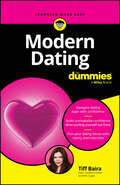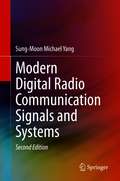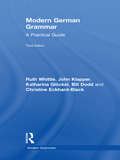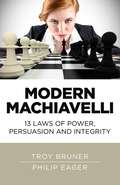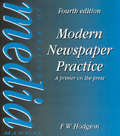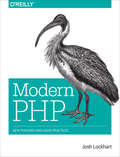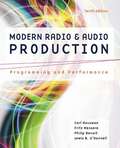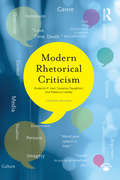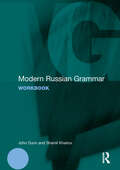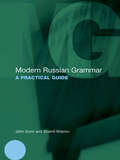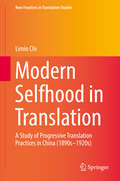- Table View
- List View
Modern Cryptography: Applied Mathematics for Encryption and Information Security
by William EasttomThis expanded textbook, now in its second edition, is a practical yet in depth guide to cryptography and its principles and practices. Now featuring a new section on quantum resistant cryptography in addition to expanded and revised content throughout, the book continues to place cryptography in real-world security situations using the hands-on information contained throughout the chapters. Prolific author Dr. Chuck Easttom lays out essential math skills and fully explains how to implement cryptographic algorithms in today's data protection landscape. Readers learn and test out how to use ciphers and hashes, generate random keys, handle VPN and Wi-Fi security, and encrypt VoIP, Email, and Web communications. The book also covers cryptanalysis, steganography, and cryptographic backdoors and includes a description of quantum computing and its impact on cryptography. This book is meant for those without a strong mathematics background with only just enough math to understand the algorithms given. The book contains a slide presentation, questions and answers, and exercises throughout.Presents new and updated coverage of cryptography including new content on quantum resistant cryptography;Covers the basic math needed for cryptography - number theory, discrete math, and algebra (abstract and linear);Includes a full suite of classroom materials including exercises, Q&A, and examples.
Modern Dance Terminology: The ABC's Of Modern Dance As Defined By Its Originators
by Paul LoveModern dance concepts, terms, principles, and movements are defined in the words of the great founders of modern dance.
Modern Dating For Dummies
by Tiff BairaNYC's TikTok Cupid presents a must-have dating guide for building confidence and finding lasting love! Dating can be fun, exciting, draining, disorienting, dangerous, and more. And if you're one of the millions of people in the market for a new partner (or two), how can you make sure that your dating life is more exhilarating than exhausting? Enter Modern Dating For Dummies, a straight-forward and friendly guide to getting the most out of contemporary dating without ending up as a cautionary tale in the next catfishing documentary on your favorite streaming service. Author Tiff Baira, NYC's official TikTok Cupid and dating guru, walks you through how to date like a champ. You'll learn how to sort the Red and Green flags, how to keep your confidence high (or get it back), protect against outright scams and frauds, and navigate new kinds of relationships. You'll also discover: How to emotionally deal with being ghosted and manage your relationship anxiety Exactly what to do after a first date that went REALLY well (or terribly sideways) How to manage the overwhelming combo of online dating and IRL Encounters that shape the modern dating space. Master the modern dating scene with today's top apps Whether you're looking for help on how to date after the end of a long relationship or you just need a few tips on how to use apps, flirt, get out of a situationship or how to find your next hookup-slash-soulmate-slash-spouse, Modern Dating For Dummies has the info you can put to work immediately to make your dating life better, easier, and more fun.
Modern Digital Radio Communication Signals and Systems
by Sung-Moon Michael YangThis book serves as an easily accessible reference for wireless digital communication systems. Topics are presented with simple but non-trivial examples and then elaborated with their variations and sophistications. It includes numerous examples and exercises to illustrate key points. The book emphasizes both practical problem solving and a thorough understanding of fundamentals, aiming to realize the complementary relationship between practice and theory. Though the author emphasize wireless radio channels, the fundamentals that are covered are useful to different channels - digital subscriber line, coax, power lines, optical fibers, and even Gigabit serial interconnection. This book is the outgrowth of the author’s hands-on experience in the telecommunication systems industry as a research and development engineer. It is written primarily for practitioners of wireless digital communication systems – engineers and technical leaders and managers – and for digital communication systems in general including new comers like graduate students and upper-division undergraduate students. The material in chapters 5(OFDM), 6(Channel coding), 7(Synchronization) and 8(Transceivers) contains something new, not explicitly available in typical textbooks, and useful in practice. For example, in Chapter 5, all known orthogonal frequency division multiplex signals are formulated based on pulse shape and thus flexible, e.g., unlike currently predominant symbol block transmission, it can be serial transmission. In Chapter 6, we emphasize practical applications of powerful error coding such as LDPC to higher order modulations, fading, and non-linearity problem. In Chapter 7, new digital timing detectors are suggested for small access bandwidth shaping pulse, and a digital quadrature imbalance correction is also included along with digital carrier phase recovery. In Chapter 8, low IF digital image cancelling transceiver is treated in detail so that practical implementation can be readily done with advantages.
Modern Digital Radio Communication Signals and Systems
by Sung-Moon Michael YangThis book serves as an easily accessible reference for wireless digital communication systems. Topics are presented with simple but non-trivial examples and then elaborated with their variations and sophistications. The book includes numerous examples and exercises to illustrate key points. For this new edition, a set of problems at the end of each chapter is added, for a total of 298 problems. The book emphasizes both practical problem solving and a thorough understanding of fundamentals, aiming to realize the complementary relationship between practice and theory. Though the author emphasizes wireless radio channels, the fundamentals that are covered here are useful to different channels - digital subscriber line, coax, power lines, optical fibers, and even Gigabit serial connections. The material in chapters 5 (OFDM), 6 (Channel coding), 7 (Synchronization), and 8 (Transceivers) contains new and updated information, not explicitly available in typical textbooks, and useful in practice. For example, in chapter 5, all known orthogonal frequency division multiplex signals are derived from its digitized analog FDM counterparts. Thus, it is flexible to have different pulse shape for subcarriers, and it can be serial transmission as well as block transmission. Currently predominant cyclic prefix based OFDM is a block transmission using rectangular pulse in time domain. This flexibility may be useful in certain applications. For additional information, consult the book support website: https://baycorewireless.com
Modern Electronic Communication (9th edition)
by Gary M. Miller Jeffrey S. BeasleyMaintaining the tradition of previous editions, this ninth edition includes up-to-date coverage of the latest in electronic communications and concepts. The material presented reflects advancements and developments in all aspects of electronic communications such as mobile communications, satellite communications, digital signal processing and SS7 signaling. Electronic Workbench Multisim simulations appear at the end of each chapter and on an accompanying CD. In addition, in-text learning aids are designed to develop analytical and troubleshooting skills and the updated lab manual includes new experiments using Mini-Circuits modules. Expanded discussion of digital communications including new changes and improvements in: Mobile Communications; SS7 Signaling; Bluetooth; Wi-Max; DTV (digital television). Completely new sections on: Wireless Security; DSP (digital signal processing); RFID; HD Radio. A thorough and up-to-date reference for Electronic Technicians.
Modern Electronics Devices and Communication Systems: Select Proceedings of MEDCOM 2021 (Lecture Notes in Electrical Engineering #948)
by Dinesh Kumar Singh Rajeev Agrawal Chandramani Kishore Singh Ayush GoyalThis book presents select and peer-reviewed proceedings of the International Conference on Smart Communication and Imaging Systems (MEDCOM 2021). The contents explore the recent technological advances in the field of next-generation electronics devices and communication systems. The topics include the design and development of smart, secure, and reliable future communication networks; satellite, radar, and microwave techniques for intelligent communication. The book also covers methods and applications of GIS and remote sensing; medical image analysis and its applications in smart health. This book can be useful for students, researchers, and professionals working in the field of communication systems and image processing.
Modern German Grammar Workbook (Modern Grammar Workbooks)
by Heidi Zojer John Klapper Ruth Whittle William J Dodd Christine Eckhard-BlackModern German Grammar Workbook, Third Edition, is an innovative book of exercises and language tasks for intermediate and advanced learners of German. The book is divided into three sections: Section 1 provides exercises based on essential grammatical structures. Section 2 practises everyday functions (e.g. making introductions, apologising, expressing needs). Section 3 contains realistic role-plays in short scenes, set in a range of different contexts. A comprehensive answer key at the back of the book enables you to check on your progress. Implementing feedback from users of the second edition, this third edition now features: even more extensive cross-referencing to the related Modern German Grammar, Third Edition spelling following the latest reform representation of the German of Switzerland and Austria. Modern German Grammar Workbook, Third Edition, is ideal for all learners who want to deepen their knowledge of German, including intermediate and advanced students at schools, in adult education and within higher education. It can be used independently or alongside Modern German Grammar, Third Edition (ISBN 978-0-415-56726-8) also published by Routledge.
Modern German Grammar: A Practical Guide (Modern Grammars)
by John Klapper Ruth Whittle Christine Eckhard-Black Katharina Glöckel Bill DoddModern German Grammar: A Practical Guide, Third Edition is an innovative reference guide to German, combining traditional and function-based grammar in a single volume. The Grammar is divided into two parts. Part A covers grammatical categories such as word order, nouns, verbs and adjectives. Part B is organised according to language functions and notions such as: making introductions asking for something to be done delivering a speech possibility satisfaction. The book addresses learners’ practical needs and presents grammar in both a traditional and a communicative setting. New to this edition, and building on feedback from the previous edition: The rules of the latest (and so far final) spelling reform have been implemented throughout. Examples of usage have been updated and consideration given to Swiss and Austrian variants. The chapter on register has been expanded and now includes youth language and frequently used Anglicisms in German. The Index now has even more key words; it has also been redesigned to differentiate between German words, grammar terms, and functions, thus making it more user-friendly. The Grammar assumes no previous grammatical training and is intended for all those who have a basic knowledge of German, from intermediate learners in schools and adult education to undergraduates taking German as a major or minor part of their studies. The Grammar is accompanied by a third edition of Modern German Grammar Workbook (ISBN 978-0-415-56725-1) which features exercises and activities directly linked to the Grammar. Ruth Whittle is Lecturer, John Klapper is Professor of Foreign Language Pedagogy, Katharina Glöckel is the Austrian Lektorin and Bill Dodd is Professor of Modern German Studies – all at the University of Birmingham. Christine Eckhard-Black is Tutor and Advisor in German at the Oxford University Language Centre.
Modern Industrial IoT, Big Data and Supply Chain: Proceedings of the IIoTBDSC 2020 (Smart Innovation, Systems and Technologies #218)
by Víctor Méndez Muñoz Muthu Ramachandran Victor ChangThis book is a collection of selected papers presented at the First International Conference on Industrial IoT, Big Data and Supply Chain (IIoTBDSC), held as an online conference due to COVID-19 (initially to be held in Macao, Special Administration Region (SAR) of China), during September 15–17, 2020. It includes novel and innovative work from experts, practitioners, scientists and decision-makers from academia and industry. It brings multi-disciplines together on IIoT, data science, cloud computing, software engineering approaches to design, development, testing and quality of products and services.
Modern Irish: A Comprehensive Grammar (Routledge Comprehensive Grammars)
by Nancy StensonModern Irish: A Comprehensive Grammar is a complete reference guide to modern Irish grammar, providing a thorough overview of the language. Key features include: highly systematic coverage of all levels of structure: sound system, word formation, sentence construction and connection of sentences authentic examples and English translations which provide an accessible insight into the mechanics of the language an extensive index, numbered sections, cross-references and summary charts which provide readers with easy access to the information. Modern Irish: A Comprehensive Grammar is an essential reference source for the learner and user of Irish. It is ideal for use in schools, colleges, universities, and adult classes of all types.
Modern Italian Grammar Workbook (Modern Grammar Workbooks)
by Anna ProudfootThis is an innovative book of exercises and language tasks for all learners of Italian, which can be used independently or alongside Modern Italian Grammar. Divided into three sections, this highly useful text includes: exercises based on essential grammatical structures everyday functions practice such as making introductions and expressing needs realistic role plays in short scenes, set in a range of different contexts. Implementing feedback from its predecessor, this updated second edition features exercises graded on a three-point scale according to their level of difficulty and cross-referencing to the Modern Italian Grammar for each. Also containing a comprehensive answer key for checking progress, this is a complete reference work suitable for both class-use and self-study.
Modern Legal Drafting
by Peter ButtIn the second edition of this highly regarded text, the authors show how and why traditional legal language has developed the peculiar characteristics that make legal documents inaccessible to the end users. Incorporating recent research and case law, the book provides a critical examination of case law and the rules of interpretation. Detailed case studies illustrate how obtuse or outdated words, phrases and concepts can be rewritten, reworked or removed altogether. Particularly useful is the step-by-step guide to drafting in the modern style, using examples from four types of common legal documents: leases, company constitutions, wills and conveyances. Readers will gain an appreciation of the historical influences on drafting practice and the use of legal terminology. They will learn about the current moves to reform legal language, and receive clear instruction on how to make their writing clearer and their legal documents more useful.
Modern Machiavelli: 13 Laws of Power, Persuasion and Integrity
by Troy Bruner Philip EagerModern Machiavelli will teach you smart, social tactics to advance your career and improve your relationships. This book explains how to successfully manage conflict, influence others, and understand the overt and covert dynamics of interpersonal power. It challenges false but commonly held beliefs that undermine personal and career success. Master the unwritten rules of the social game that few understand.
Modern Newspaper Practice: A primer on the press (Media Manuals Ser.)
by F W HodgsonAn introduction to all aspects of newspaper journalism and the journalist's world. The book examines in detail not only day-to-day practice but also the role of the editor and the reading public, and the running and printing of newspapers. Close attention in this new edition is paid to the effect of technological advance on news gathering, news and feature writing, page planning and design and the production, advertising and commercial side of newspapers. This book is widely used on journalism and media-related courses, including degrees and those run by newspaper companies and the NCTJ, and the many training schemes abroad that look at British practice.
Modern PHP: New Features and Good Practices
by Josh LockhartPHP is experiencing a renaissance, though it may be difficult to tell with all of the outdated PHP tutorials online. With this practical guide, you’ll learn how PHP has become a full-featured, mature language with object-orientation, namespaces, and a growing collection of reusable component libraries.Author Josh Lockhart—creator of PHP The Right Way, a popular initiative to encourage PHP best practices—reveals these new language features in action. You’ll learn best practices for application architecture and planning, databases, security, testing, debugging, and deployment. If you have a basic understanding of PHP and want to bolster your skills, this is your book.Learn modern PHP features, such as namespaces, traits, generators, and closuresDiscover how to find, use, and create PHP componentsFollow best practices for application security, working with databases, errors and exceptions, and moreLearn tools and techniques for deploying, tuning, testing, and profiling your PHP applicationsExplore Facebook’s HVVM and Hack language implementations—and how they affect modern PHPBuild a local development environment that closely matches your production server
Modern Radio and Audio Production: Programming and Performance (Tenth Edition)
by Carl Hausman Frank Messere Lewis B. O'Donnell Philip BenoitIntegrating cutting-edge technologies with explanations of traditional equipment and practices, MODERN RADIO AND AUDIO PRODUCTION, 10e, offers current, comprehensive coverage of radio production and programming. A clear writing style, excellent descriptions and explanations, and attention to detail make this book easy to read and understand. An all-new chapter on writing walks you step by step through the entire process, while a new chapter on ethics helps you think through possible ethical dilemmas before you encounter them in the workplace. In addition, an all-new chapter on mobile radio explores the next frontier.
Modern Requirements for Noise Immunity Aircraft Navigation Equipment (Springer Aerospace Technology)
by Oleg Ivanovich Zavalishin Dmitry Alexandrovich Zatuchny Yury Grigorievich ShatrakovThis book presents a technical solution to ensuring the noise immunity of navigation systems in civil aviation aircrafts at the stages of their terminal procedures. It highlights instrumental precision approaches to landing and landing in automatic mode using satellite and inertial radio navigation systems and ground-based augmentation used as the primary means, in accordance with the ICAO requirements. The book is intended for engineering and technical specialists engaged in the development, manufacture and operation of on-board radio electronic systems of aircrafts and ground-based radio engineering support for flights, as well as graduate students and senior students of radio engineering specialties. It is also useful for professionals whose activities are related to air traffic control.
Modern Rhetorical Criticism
by Roderick P Hart Suzanne M. Daughton Rebecca LavallyA comprehensive and up-to-date introduction to the analysis of public rhetoric, Modern Rhetorical Criticism teaches readers how to examine and interpret rhetorical situations, ideas, arguments, structure, and style. The text covers a wide range of critical techniques, from cultural and dramatistic analysis to feminist and Marxist approaches. A wealth of original criticism demonstrates how to analyze such diverse forms as junk mail, campaign speeches, and popular entertainment, as well as literature. This long-awaited revision offers specific guidance on crafting analytic essays, and contains new coverage of legacy as well as new media, identity criticism, and post-colonial and decolonial criticism. The fourth edition also offers additional resources online for instructors and students.
Modern Rhetorical Criticism
by Roderick P Hart Suzanne DaughtonA comprehensive and up-to-date introduction to the analysis of public rhetoric, Modern Rhetorical Criticism teaches readers how to examine and interpret rhetorical situations, ideas, arguments, structure, and style. The text covers a wide range of critical techniques, from cultural and dramatistic analysis to feminist and Marxist approaches. A wealth of original criticism demonstrates how to analyze such diverse forms as junk mail, congressional debates, and traffic regulations, as well as literature. This long-awaited revision contains new coverage of mass media, feminist criticism, and European criticism.
Modern Russian Grammar Workbook (Modern Grammar Workbooks)
by John Dunn Shamil KhairovModern Russian Grammar Workbook is an innovative book of exercises and language tasks for all learners of Russian. The book is divided into two parts. Section 1 provides exercises based on essential grammatical structures. Section 2 practises everyday functions such as making introductions, apologizing and expressing needs. A comprehensive answer key at the back of the book enables students to check on their progress. Main features include: exercises graded according to level of difficulty cross referencing to the related Modern Russian Grammar topical exercises which develop students’ vocabulary base. The Modern Russian Grammar Workbook is ideal for all learners of Russian, from beginner to intermediate and advanced students. It can be used both independently and alongside the Modern Russian Grammar: A Practical Guide, also published by Routledge. John Dunn is Honorary Research Fellow and Shamil Khairov is Lecturer in Russian, both at the School of Modern Languages and Cultures, University of Glasgow.
Modern Russian Grammar: A Practical Guide (Modern Grammars #Vol. 3)
by John Dunn Shamil KhairovModern Russian Grammar: A Practical Guide is an innovative reference guide to Russian, combining traditional and function-based grammar in a single volume. The Grammar is divided into two parts. Part A covers traditional grammatical categories such as agreement, nouns, verbs and adjectives. Part B is carefully organized around language functions covering all major communication situations. With a strong emphasis on contemporary usage, all grammar points and functions are richly illustrated with examples. Main features of the Grammar include: clear explanations emphasis on areas of particular difficulty for learners of Russian, such as numerals and verbs of motion extensive cross-referencing between the different sections. This is the ideal reference grammar for learners of Russian at all levels, from beginner to advanced. No prior knowledge of grammatical terminology is assumed and a glossary of grammatical terms is provided.
Modern Selfhood in Translation: A Study Of Progressive Translation Practices In China (1890s-1920s) (New Frontiers In Translation Studies)
by Limin ChiThis book examines the development of Chinese translation practice in relation to the rise of ideas of modern selfhood in China from the 1890s to the 1920s. The key translations produced by late Qing and early Republican Chinese intellectuals over the three decades in question reflect a preoccupation with new personality ideals informed by foreign models and the healthy development of modern individuality, in the face of crises compounded by feelings of cultural inadequacy. The book clarifies how these translated works supplied the meanings for new terms and concepts that signify modern human experience, and sheds light on the ways in which they taught readers to internalize the idea of the modern as personal experience. Through their selection of source texts and their adoption of different translation strategies, the translators chosen as case studies championed a progressive view of the world: one that was open-minded and humanistic. The late Qing construction of modern Chinese identity, instigated under the imperative of national salvation in the aftermath of the First Sino-Japanese War, wielded a far-reaching influence on the New Culture discourse. This book argues that the New Culture translations, being largely explorations of modern self-consciousness, helped to produce an egalitarian cosmopolitan view of modern being. This was a view favoured by the majority of mainland intellectuals in the post-Maoist 1980s and which has since become an important topic in mainland scholarship.
Modern Sensing Technologies (Smart Sensors, Measurement and Instrumentation #29)
by Subhas Chandra Mukhopadhyay Octavian Adrian Postolache Krishanthi P. JayasunderaThis book provides an overview of modern sensing technologies and reflects the remarkable advances that have been made in the field of intelligent and smart sensors, environmental monitoring, health monitoring, and many other sensing and monitoring contexts in today’s world. It addresses a broad range of aspects, from human health monitoring to the monitoring of environmental conditions, from wireless sensor networks and the Internet of Things to structural health monitoring. Given its breadth of scope, the book will benefit researchers, practitioners, technologists and graduate students involved in the monitoring of systems within the human body, functions and activities, healthcare technologies and services, the environment, etc.
Modern Socio-Technical Perspectives on Privacy
by Nicholas Proferes Bart P. Knijnenburg Xinru Page Pamela Wisniewski Heather Richter Lipford Jennifer RomanoThis open access book provides researchers and professionals with a foundational understanding of online privacy as well as insight into the socio-technical privacy issues that are most pertinent to modern information systems, covering several modern topics (e.g., privacy in social media, IoT) and underexplored areas (e.g., privacy accessibility, privacy for vulnerable populations, cross-cultural privacy). The book is structured in four parts, which follow after an introduction to privacy on both a technical and social level: Privacy Theory and Methods covers a range of theoretical lenses through which one can view the concept of privacy. The chapters in this part relate to modern privacy phenomena, thus emphasizing its relevance to our digital, networked lives. Next, Domains covers a number of areas in which privacy concerns and implications are particularly salient, including among others social media, healthcare, smart cities, wearable IT, and trackers. The Audiences section then highlights audiences that have traditionally been ignored when creating privacy-preserving experiences: people from other (non-Western) cultures, people with accessibility needs, adolescents, and people who are underrepresented in terms of their race, class, gender or sexual identity, religion or some combination. Finally, the chapters in Moving Forward outline approaches to privacy that move beyond one-size-fits-all solutions, explore ethical considerations, and describe the regulatory landscape that governs privacy through laws and policies. Perhaps even more so than the other chapters in this book, these chapters are forward-looking by using current personalized, ethical and legal approaches as a starting point for re-conceptualizations of privacy to serve the modern technological landscape. The book’s primary goal is to inform IT students, researchers, and professionals about both the fundamentals of online privacy and the issues that are most pertinent to modern information systems. Lecturers or teachers can assign (parts of) the book for a “professional issues” course. IT professionals may select chapters covering domains and audiences relevant to their field of work, as well as the Moving Forward chapters that cover ethical and legal aspects. Academics who are interested in studying privacy or privacy-related topics will find a broad introduction in both technical and social aspects.


